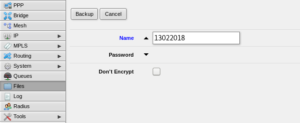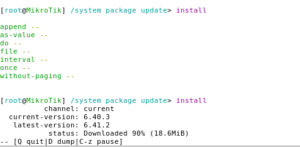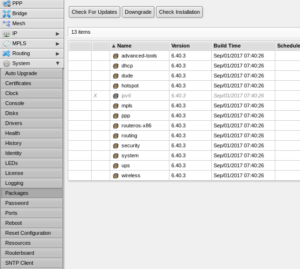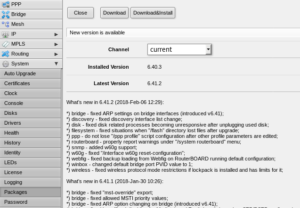With the new version – 6.41.2, Mikrotik brings a lot of new functionalities and fixed bugs. For full information check the changelog on their website, for this release the most significant change is the new bridge implementation.
We will start with the update itself – but first remember to make a backup of your current configuration:
Tab “Files” and click on the “Backup” button:

This will save the configuration into non-readable format, so if you want to have a copy which you can freely edit, do the following:
Open “Terminal” -> and type /export , this will print the whole configuration into the terminal, pretty much the same as show running-config on cisco and after that you can copy and paste it into a text file. Other option is to safe the export as a file on the Mikrotik itself:
/export file=NameOfTheFile
and it will be saved into /files as .rsc file.
Updates
Updates on Mikrotik can be done through the terminal and on both Webfig and Winbox, too.
Terminal
Check for the new available versions:
/system package update check-for-updates

Here, we will update from 6.40.3 up to 6.41.2 (stable).
To proceed with the update:
This will automatically download, install and reboot your machine:
/system package update install

Downtime is around 40 ping drops:
64 bytes from xxx.xxx.xxx.xxx: icmp_seq=5 ttl=60 time=3.50 ms 64 bytes from xxx.xxx.xxx.xxx: icmp_seq=43 ttl=60 time=1.11 ms
If you are using Webfig, you will have to press F5 to reload the page.
/system package update print
![]()
Webfig
Go to: System -> Packages -> Check For updates -> Download & Install


In order for the update to take place, the device must be rebooted.
Bridge functionality
So far we had one or two master-ports and in case you wanted to enable a switch functionality, between several ports, you were supposed to add them as slaves to the master ports. In this way you will use the switch chip, where the switching is made on a hardware level (ASIC), instead in the software as if you create a bridge.
With RouterOS 6.41 was announced the new bridge functionality:
- Bridges will handle all of the Layer 2 forwarding , accessing the switch chip and using thе hardware offloading.
- As additional feature, MSTP has been added along with IGMP snooping.